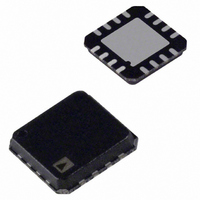AD8231ACPZ-RL Analog Devices Inc, AD8231ACPZ-RL Datasheet - Page 20

AD8231ACPZ-RL
Manufacturer Part Number
AD8231ACPZ-RL
Description
IC,Instrumentation Amplifier,SINGLE,LLCC,16PIN,PLASTIC
Manufacturer
Analog Devices Inc
Datasheet
1.AD8231-EVALZ.pdf
(24 pages)
Specifications of AD8231ACPZ-RL
Amplifier Type
Instrumentation
Number Of Circuits
2
Output Type
Rail-to-Rail
Slew Rate
1.1 V/µs
Gain Bandwidth Product
7MHz
Current - Input Bias
250pA
Voltage - Input Offset
4µV
Current - Supply
4mA
Current - Output / Channel
70mA
Voltage - Supply, Single/dual (±)
3 V ~ 6 V, ±1.5 V ~ 3 V
Operating Temperature
-40°C ~ 125°C
Mounting Type
Surface Mount
Package / Case
16-LFCSP
Lead Free Status / RoHS Status
Lead free / RoHS Compliant
For Use With
AD8231-EVALZ - BOARD EVAL FOR AD8231
-3db Bandwidth
-
Lead Free Status / RoHS Status
Lead free / RoHS Compliant
AD8231
RF INTERFERENCE
RF rectification is often a problem when amplifiers are used in
applications where there are strong RF signals. The disturbance
can appear as a small dc offset voltage. High frequency signals
can be filtered with a low-pass, RC network placed at the
input of the instrumentation amplifier, as shown in Figure 52.
The filter limits the input signal bandwidth according to the
following relationship
where C
Figure 52 shows an example where the differential filter frequency
is approximately 2 kHz, and the common-mode filter frequency
is approximately 40 kHz.
Values of R and C
between the R × C
negative input degrades the CMRR of the AD8231. By using a
value of C
effect of the mismatch is reduced and performance is improved.
COMMON-MODE INPUT VOLTAGE RANGE
The 3-op amp architecture of the AD8231 applies gain and then
removes the common-mode voltage. Therefore, internal nodes
in the AD8231 experience a combination of both the gained
signal and the common-mode signal. This combined signal can
be limited by the voltage supplies even when the individual input
and output signals are not. To determine whether the signal could
be limited, refer to Figure 12 through Figure 14 or use the
following formula
FilterFreq
FilterFreq
−
V
D
S
≥ 10 C
+
D
4.02kΩ
4.02kΩ
that is ten times larger than the value of C
. 0
R
R
04
Diff
CM
C
V
.
C
=
=
should be chosen to minimize RFI. Mismatch
C
<
at the positive input and the R × C
2
C
1nF
C
10nF
C
1nF
2
V
C
D
C
Figure 52. RFI Suppression
π
π
CM
RC
1
R
(2
±
C
C
1
0.1µF
0.1µF
V
+INA
–INA
D
DIFF
+
C
C
2
×
AD8231
)
+V
–V
Gain
S
S
<
REF
+
10µF
10µF
V
S
−
V
OUT
. 0
04
C
C
V
, the
at the
Rev. A | Page 20 of 24
If more common-mode range is required, the simplest solution is
to apply less gain in the instrumentation amplifier. The extra op
amp can be used to provide another gain stage after the in-amp.
Because the AD8231 has good offset and noise performance at low
gains, applying less gain in the instrumentation amplifier generally
has a limited impact on the overall system performance.
REDUCING NOISE
Because the AD8231 has no 1/f noise, reducing the bandwidth
corresponds directly to less noise. Table 8 shows the AD8231
performance at a gain of 1 at different bandwidths, assuming a
2-pole Butterworth filter roll off.
Table 8. AD8231 noise at various bandwidths
Bandwidth
(Hz)
1
3.2
10
32
100
320
1 k
3.2 k
10 k
32 k
1
2
The AD8231 has two clocks: an auto-zero clock at 3.4 kHz and
a commutating clock at 54 kHz. While the auto-zero clock has
negligible energy and can generally be ignored, the commutating
clock has enough energy to significantly affect the noise of the
part. Therefore, in applications where low noise is critical, limiting
the bandwidth of the system below 54 kHz is recommended.
SNR for single-ended output configuration calculated with output signal of
SNR for differential output configuration calculated with output signal of
4.8 V p-p, which corresponds to 1.697 V rms.
9.6 V p-p, which corresponds to 3.397 V rms.
Noise
(μV rms)
0.07
0.12
0.21
0.37
0.66
1.17
2.07
3.71
6.55
11.73
SNR
Single-Ended
dB
148.3
143.2
138.3
133.2
128.3
123.2
118.3
113.2
108.3
103.2
Bits
24.3
23.5
22.7
21.8
21.0
20.2
19.3
18.5
17.7
16.9
1
SNR Differential
Output
dB
144.3
139.2
137.63
129.2
124.3
119.2
117.3
154.3
149.2
109.2
2
Bits
25.3
24.5
23.7
22.8
22.0
21.2
20.3
19.5
18.7
17.9













